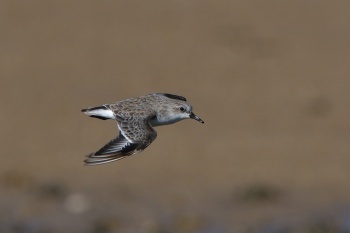- Calidris ruficollis
Identification
Length 13–16 cm (5-6¼ in), wingspan 29–33 cm, weight 18–50 g
- A small, rather short-legged stint with black legs and short black bill
Breeding
- Russet head and upper breast, but small white chin patch
- Rufous upperparts with black mottling
- Grey wing coverts
- Dark streaks on lower breast
- White belly
- Straight black bill
Winter
- White head with black streaks
- Grey upperparts mottle black
- White underparts
Juvenile
- Rusty brown mantle and scapular feathers with blackish centres and pale fringes; wing coverts greyer, contrasting with the rufous-toned upperparts.
Similar Species
Winter and juvenile birds are very similar to Semipalmated Sandpiper and Little Stint. Juveniles best told from Little Stint by the greyer wing coverts, less obvious supercilium, and marginally shorter legs. Summer adults can be confused surprisingly easily with Sanderling where the latter's larger size and lack of a hind toe is hidden from view.
Distribution
Breeds primarily in arctic northeast Siberia; a few also in the far northwest of Alaska in the United States.
It migrates south through Siberia, Mongolia, China, and Japan, to winter in eastern India, southeast Asia, and most importantly Australia (350,000 birds); a few hundred reach New Zealand.
Vagrant west to Europe (including the British Isles) and east to the rest of the United States, mostly the north east and west coasts.
Taxonomy
Closely related to Little Stint. This is a monotypic species[1].
Habitat
Breeds on tundra. During migration and in the winter feeds on bare sand or dry mud areas, tidal mudflats, lagoons, freshwater marshes, lakes and ricefields.
Behaviour
Breeding
Their nest is a shallow depression on the ground.
Diet
During the breeding season the diet consists of beetles, insect larvae and other small invertebrates as well as some seeds.
References
- Clements, J. F., T. S. Schulenberg, M. J. Iliff, D. Roberson, T. A. Fredericks, B. L. Sullivan, and C. L. Wood. 2016. The eBird/Clements checklist of birds of the world: v2016, with updates to August 2016. Downloaded from http://www.birds.cornell.edu/clementschecklist/download/
- Collins Field Guide 5th Edition ISBN 0 00 219900 9
- Collins Bird Guide ISBN 0 00 219728
- What Bird
- BF Member observations
- Handbook of the Birds of the World Alive (retrieved Oct 2017)
Recommended Citation
- BirdForum Opus contributors. (2024) Red-necked Stint. In: BirdForum, the forum for wild birds and birding. Retrieved 23 April 2024 from https://www.birdforum.net/opus/Red-necked_Stint
External Links
Search the Gallery using the scientific name:
Search the Gallery using the common name:
GSearch checked for 2020 platform.







